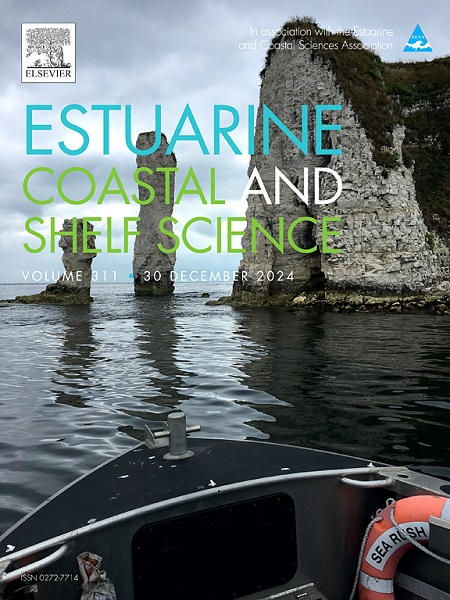过去几十年葡萄牙河口鱼类多样性趋势及面对全球变化的预测
IF 2.6
3区 地球科学
Q1 MARINE & FRESHWATER BIOLOGY
引用次数: 0
摘要
河口等沿海过渡生态系统是地球上最富饶的水生生态系统之一,在生物相关性和人类使用方面是世界公认的沿海地区的基本组成部分。葡萄牙沿海河口的地貌和水文特征各不相同。这些系统在重要经济鱼类的育苗区方面发挥着至关重要的作用。虽然一些学者已经观察到葡萄牙沿海河口鱼类群落具有很高的特定变异性,但很少有研究探讨其影响因素。这些研究大多集中在一个河口,即使涉及多个河口,也仅使用一个因素来评估群落的具体变化。本研究旨在利用葡萄牙海岸监测网络研究基础设施(CoastNet RI)提供的 30 年历史数据库,分析这些河口对鱼类群落所起的生态作用,即物种丰富度。为此,我们开发了一个广义加法模型(GAM),以分析葡萄牙沿海九个主要河口系统中物种丰富度的变化与一系列时间、空间和环境特征的函数关系。共鉴定出 45 个科 142 个物种。特茹河口、米拉河口和萨多河口的物种数量最多(分别为 92 种、72 种和 64 种),而米尼奥河口和阿威罗河口的物种数量最少(分别为 26 种和 27 种)。GAM 模型解释了物种丰富度变异的 35.1%,表明鱼类物种丰富度在空间(九个研究河口之间)和时间(年度和月度尺度)上存在显著差异,这些差异受到盐度和温度等非生物因素的影响。物种丰富度随着纬度的升高而降低,并逐年变化,2002 年后呈下降趋势。月度变化显示,2-3 月和 9-10 月物种丰富度有所上升。物种丰富度较高与盐度在 25 至 37 之间和温度在 14 至 25 ℃之间有关。此外,还讨论了气候变化对重要因素的影响可能导致的未来变化情景。这些 GAMs 可以作为初步工具,为国家立法制定长期保护计划提供帮助。本文章由计算机程序翻译,如有差异,请以英文原文为准。
Trends in fish diversity in Portuguese estuaries in the past decades and predictions in face of global changes
Coastal transition ecosystems like estuaries are amongst the most productive aquatic ecosystems on the planet, recognized worldwide as a fundamental component of coastal areas in terms of biological relevance and anthropogenic use. Estuaries along the Portuguese coast differ in their geomorphological and hydrological characteristics. These systems play a crucial role in terms of nursery areas for economically important fish species. Although several authors have observed high specific variability in estuarine fish communities along the Portuguese coast, few studies explore the factors that influence it. Most of these studies focus on a single estuary and, when several are addressed, only a single factor is used to assess the specific variability of the communities. The presente work aims to analyze the ecological role played by these estuaries for fish communities, namely in terms of their species richness, using a 30 year historical database provided by the Portuguese Coastal Monitoring Network Research Infrastructure (CoastNet RI). To this end, a generalized additive model (GAM) was developed to analyze the variation of species richness as a function of a set of temporal, spatial and environmental characteristics from the nine principal estuarine systems on the Portuguese coast. A total of 142 species from 45 families were identified. The Tejo, Mira, and Sado estuaries had the highest species counts (92, 72, and 64 species, respectively), while Minho and Ria de Aveiro had the lowest (26 and 27 species, respectively). The GAM model explained 35.1% of the variance in species richness and demonstrated significant differences in fish species richness in space (among the nine study estuaries) and time (at annual and monthly scales), and these differences were influenced by abiotic factors such as salinity and temperature. Species richness decreased with higher latitudes and varied yearly, showing a downward trend post-2002. Monthly variations showed increases in February–March and September–October. Higher species richness correlated with salinity levels between 25 and 37 and temperatures between 14 and 25 °C. Possible scenarios of future variations caused by the effects of climate change on the significant factors are also discussed. These GAMs could be useful as a preliminary tool to prepare long-term conservation plans for national legislation.
求助全文
通过发布文献求助,成功后即可免费获取论文全文。
去求助
来源期刊
CiteScore
5.60
自引率
7.10%
发文量
374
审稿时长
9 months
期刊介绍:
Estuarine, Coastal and Shelf Science is an international multidisciplinary journal devoted to the analysis of saline water phenomena ranging from the outer edge of the continental shelf to the upper limits of the tidal zone. The journal provides a unique forum, unifying the multidisciplinary approaches to the study of the oceanography of estuaries, coastal zones, and continental shelf seas. It features original research papers, review papers and short communications treating such disciplines as zoology, botany, geology, sedimentology, physical oceanography.

 求助内容:
求助内容: 应助结果提醒方式:
应助结果提醒方式:


